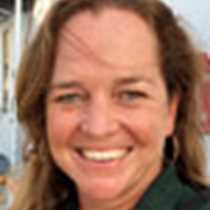Santa Cruz
Santa Cruz Island is located at the heart of the Galápagos Archipelago and was the focus of our visit today. This island offered us some very different experiences: after having spent five days surrounded by nothing but sea, rocks, plants and wildlife it is quite a shock initially to be surrounded by bustling human activity. Its central location and proximity to the oldest airport in Galápagos has stimulated a great amount of settlement on this beautiful island. Although it was the last of four islands to become inhabited by humans, it is home to well over half the total population of the archipelago, and is also the nerve-centre of both tourism and conservation in Galápagos.
We anchored bright and early in Academy Bay, a large south-facing bay that was named after the California Academy of Science, who set up a 6-month scientific camp in the area in 1905 – 1906. Our fleet of Zodiacs took us into the busy port town of Puerto Ayora, and we landed at the National Park Service dock. Thanks to the tireless work of this governmental institution, advised scientifically over the years by their partner in Galápagos conservation, the Charles Darwin Foundation, the islands have far better conservation prospects today than 50 years ago. As such, they represent a global opportunity to create a model of sustainable use of nature whilst conserving a place that has had an unparalleled impact on western thought by inspiring Darwin’s theory of Natural Selection.
Although, during his five weeks in Galapagos in 1835, Darwin noticed speciation mainly within the endemic mocking birds and lava lizards, the group of birds that most readily illustrates the power of Natural Selection is that of the Darwin finches. This group of thirteen closely related small bird species, all descended from an ancestral finch species that reach Galápagos from the mainland, now shows an impressive array of different beak shapes and sizes, allowing them to exploit a wide variety of resources. In fact, these birds differentiated so much from one another that Darwin thought he was looking at completely different species (warblers, wrens, grosbeaks, sparrows) and it was not until his return to England, where the ornithologist John Gould pointed out to him that these collections were actually one family of birds, that he realized their importance. What he would have given to return to the islands to collect and observe these birds some more!
Santa Cruz is a particularly good island for finch-watching, as it is home to 10 of the 13 species, and we visit several different vegetation zones (coastal, arid, transition and endemic cloud forests) which allow us to see different groups: ground finches in the lowlands; tree finches, woodpecker, vegetarian and warbler finches in the highlands. The giant cacti forests of the arid zone of Santa Cruz are home to the cactus finch, that has evolved a long beak to get between the cactus spines, and actually builds nests in the curled up cactus pads. In addition to the finches, several other land bird species are abundant in the area, including the charming little Galápagos flycatcher.
Santa Cruz is also a wonderful island to observe the most emblematic of Galápagos species, the giant tortoise, and it is home to one of the largest populations in Galápagos. Many of our giant tortoise species were once critically endangered, but 50 years of conservation work has brought all but one (the famous Lonesome George) back from the brink of extinction, thanks to a joint program of captive breeding in the centres on Santa Cruz and Isabela and huge efforts towards the ecological restoration of the home islands prior to repatriation. Today we observed several species of giant tortoise – those that are part of the breeding program, and the Santa Cruz population in the wild.
Truly a day to remember…




